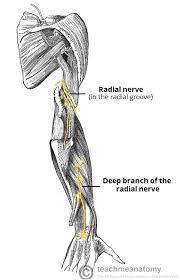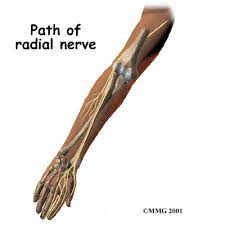
 The radial nerve is a nerve in the human body that supplies the posterior portion of the upper limb.
The radial nerve is a nerve in the human body that supplies the posterior portion of the upper limb.
It innervates the medial and lateral heads of the triceps brachii muscle of the arm, as well as all 12 muscles in the posterior osteofascial compartment of the forearm and the associated joints and overlying skin.
The radial nerve It originates from the brachial plexus, carrying fibers from the posterior roots of spinal nerves C5, C6, C7, C8 and T1.
The radial nerve is a major peripheral nerve of the upper limb, originating from the posterior cord of the brachial plexus, with roots from C5 to T1.
It is the largest branch of the brachial plexus and has a complex anatomical course.
In the axilla, the radial nerve lies posterior to the axillary artery and anterior to the subscapularis, latissimus dorsi, and teres major muscles.
It then travels posteriorly through the triangular interval, bounded by the long head of the triceps, the humerus, and the teres major muscle.
In the upper arm, the radial nerve descends in the spiral (radial) groove of the humerus, accompanied by the profunda brachii artery.
It is in close proximity to the humerus, making it susceptible to injury in humeral fractures.
The nerve gives off branches to the triceps brachii and anconeus muscles, as well as the posterior cutaneous nerve of the arm.
At the elbow, the radial nerve passes anterior to the lateral epicondyle of the humerus and divides into the superficial branch, which provides sensory innervation to the dorsum of the hand, and the deep branch (posterior interosseous nerve), which innervates the extensor muscles of the forearm.
In the forearm, the superficial branch runs along the lateral aspect, under the brachioradialis muscle, and emerges to provide sensory innervation.
The posterior interosseous nerve continues to innervate the extensor muscles and terminates in the wrist and hand.
Understanding the detailed anatomy of the radial nerve is crucial for surgical interventions and diagnosing compressive neuropathies, such as posterior interosseous nerve syndrome.
The radial nerve/ branches provide motor innervation to the dorsal arm muscles (the triceps brachii and the anconeus) and the extrinsic extensors of the wrists and hands.
The radial nerve provides cutaneous sensory innervation to most of the back of the hand, except for the back of the little finger and adjacent half of the ring finger, which are innervated by the ulnar nerve.
The radial nerve divides into a deep branch, which becomes the posterior interosseous nerve, and a superficial branch, which goes on to innervate the dorsum (back) of the hand.
The radial nerve originates as a terminal branch of the brachial plexus.
It goes through the arm, first in the posterior compartment of the arm, and later in the anterior compartment of the arm, and continues in the posterior compartment of the forearm.
The radial nerve originates from the posterior cord of the brachial plexus with root values of C5 to C8 and T1.
From the brachial plexus, it travels behind the third part of the axillary artery.
In the arm, the radial nerve runs behind the brachial artery and then enters the lower triangular space to reach the radial sulcus on the back of the humerus.
The radial nerve travels downwards together with profunda brachii artery, between the lateral and medial heads of triceps brachii until it reaches the lateral side the arm at 5 cm below the deltoid tuberosity where it pierces the lateral intermuscular septum to reach the anterior compartment of the arm.
It descends down to cross the lateral epicondyle of the humerus where the nerve terminates by branching itself into superficial and deep branch which continues into cubital fossa and then into the forearm.
The radial nerve gives out muscular branches to supply the long head, medial head, and lateral head of triceps brachii muscles before and during its course in the radial sulcus.
It emerges out from the radial sulcus, it supplies the brachialis, brachioradialis and extensor carpi radialis longus.
Above the radial sulcus, the radial nerve gives off posterior cutaneous nerve of the arm which supplies the skin at the back of the arm.
In the radius, it gives off lower lateral cutaneous nerve of the arm and posterior cutaneous nerve of the forearm.
The radial nerve also gives articular branches to supply the elbow joint.
In the forearm, it is divided into a superficial branch (primarily sensory) and a deep branch (primarily motor).
The superficial branch of the radial nerve is separated from the radial artery in the upper one third of the forearm, closely related to radial artery in the middle third of the forearm, and in the lower third, it descends in the forearm under the tendon of brachioradialis.
The superficial branch of the radial nerve crosses brachioradialis to enter posterior of forearm near the back of the wrist and supply dorsum of hand.
The superficial branch of the radial nerve gives sensory supply to dorsal aspect of hand, dorsal aspect of thumb, index finger, middle finger and lateral side of ring finger except the nail beds, which are supplied by proper digital branches of median nerve.
The deep branch of the radial nerve pierces the supinator muscle, winds around the radius and reach posterior of forearm where it again pierces supinator and after which it is known as the posterior interosseous nerve. and ends as a pseudoganglion below extensor retinaculum by supplying the wrist and intercarpal joints.
The following are branches of the radial nerve:
Cutaneous innervation by the radial nerve is provided by the following nerve branches: Posterior cutaneous nerve of arm Inferior lateral cutaneous nerve of arm Posterior cutaneous nerve of forearm
The superficial branch of the radial nerve provides sensory innervation to much of the back of the hand, including the web of skin between the thumb and index finger.
All the visible muscles except the ones on the dorsal hand are innervated by the radial nerve, and represent all muscles innervated by the radial nerve except for the supinator.
Muscular branches of the radial nerve: Triceps brachii Anconeus Brachioradialis Extensor carpi radialis longus Deep branch of the radial nerve: Extensor carpi radialis brevis Supinator Posterior interosseous nerve (a continuation of the deep branch after the supinator): Extensor digitorum Extensor digiti minimi Extensor carpi ulnaris Abductor pollicis longus Extensor pollicis brevis Extensor pollicis longus Extensor indicis
The radial nerve and its deep branch provides motor innervation to the muscles in the posterior compartment of the arm and forearm, which are mostly extensors.
Injury to the radial nerve at different levels causes different syndromes with varying motor and sensory deficits.
Damage at the axilla
Motor deficit: Loss of extension of forearm, weakness of supination, and loss of extension of hand and fingers.
Presence of wrist drop, due to inability to extend the hand and fingers.
Sensory deficit: Loss of sensation[9] in lateral arm, posterior forearm, the radial half of dorsum of hand, and dorsal aspect of radial 3+1⁄2 digits, excluding their nail beds.
At mid-arm a common mechanism of injury is a mid-shaft humeral fracture
Associated motor deficit: Weakness of supination, and loss of extension of hand and fingers.
Presence of wrist drop, due to inability to extend the hand and fingers.
Sensory deficit: Loss of sensation in posterior forearm, the radial half of dorsum of hand, and dorsal aspect of radial 3+1⁄2 digits, excluding their nail beds.
Just below the elbow common mechanism of injury: Neck of radius fracture, elbow dislocation or fracture, tight cast, rheumatoid nodules, injections due to tennis elbow, injuring the deep branch of the radial nerve that pierces the radial head, causing posterior interosseous nerve syndrome
Associated motor deficit:
Weakness in extension of hand and loss of extension of fingers.
Presence of finger drop, and partial wrist drop, since the extensor carpi radialis longus and brachioradialis muscles are working.
Sensory deficit: None, as sensation is supplied by the superficial radial nerve
Within the distal forearm:
Common mechanism of injury: Wartenberg’s syndrome, due to nerve entrapment beneath the tendinous insertion of brachioradialis, tight jewellery, and watch bands.
Motor deficit: None
Sensory deficit: Numbness and tingling in radial half of dorsum of hand, and dorsal aspect of radial 3+1⁄2 digits, excluding their nail beds.
In Wartenberg’s syndrome, there is significant radial wrist pain, and close resemblance to symptoms in de Quervain’s tenosynovitis.
Finkelstein’s test may be positive.
